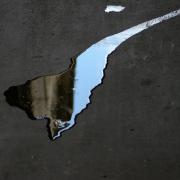Construction Moisture: Don’t mistake it for damage

Where does construction moisture come from?
You would be surprised at how much moisture newly constructed buildings contain. This water comes on board in a variety of ways, but mainly through
- Exposure to the elements: If you live in the Pacific Northwest, your construction site is going to get rained on. This is normal and nothing to worry about.
- Water of convenience in concrete, plaster and other building materials. This is the water that is used to make these materials easier to apply above what is needed to simply hydrate them.
- Moisture may be present in the material prior to incorporation into the building fabric. Again, completely normal.
The important thing to remember is that this sort of thing is commonplace and does not, on its own, usually mean trouble. The causes listed above can get a structure very close to the fiber saturation point of commonly used wood products, true. The resultant staining, however, is habitual and no cause for alarm.
Where there’s moisture there doesn’t necessarily have to be a leak
I stress this point because I see a lot of cases where evidence of construction moisture is erroneously classified as damage. It is not, and fails both litmus tests in a commonly accepted definition of damage that I explain in a previous blog. In basic terms, the function of the component must be permanently impaired or compromised for it to be considered damaged.
That said, it is equally important to remember is that function is key
Staining due to construction moisture is not damage UNLESS the staining occurs on a material with an aesthetic function. If this happens, you may have something. If not (and there aren’t other signs of active leak damage) then it probably ain’t broke.
Photo credit: jenny downing / Foter / CC BY
 Welcome to the Stewart Consulting Blog
Welcome to the Stewart Consulting Blog
Here you’ll find expert information on all things construction. If you have a specific issue you would like David to address in a blog, ask a question.

